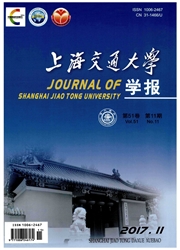

 中文摘要:
中文摘要:
采用离散元法(DEM)对无水砂土地层(摩擦角37°)3种埋深条件下盾构隧道开挖面的颗粒流动及渐进性破坏过程进行了模拟,分析研究了开挖面极限支护压力及周围地层扰动分布的变化规律,得到:①不同埋深条件下,开挖面极限支护压力均出现在开挖面位移为0.06D(D为隧道直径)时,对应支护压力比为10%-20%,砂土强度软化现象导致最终极限支护压力增大.②支护压力比降至40%-50%为剧烈地层扰动及显著地表变形的触发点.当开挖面支护压力比降低至40%-50%时,地层扰动范围和程度对隧道埋深非常敏感,如埋深由2D降低至0.5D时,扰动范围扩大了3倍,最大扰动程度提高了1倍;地表产生明显大幅沉降.③基于极限破坏的支护压力比为10%-20%,而基于变形控制的支护压力比为40%-50%,虽明显大于前者,但支护压力仅为静止土压力的40%-50%.综合考虑盾构刀盘磨损及地层支护效果,在无水砂土地层中采用支护压力比为40%-50%是一种合理选择.
 英文摘要:
英文摘要:
Using the discrete element method (DEM), the particle flow of dry sand with friction angle of 37 degree and progressive failure in a tunnel workface under three cover depths were simulated to examine the limit support pressure of workface and ground turbulence in sandy ground. These simulations resulted in three main findings. First, under different cover depths, the support pressures evolve to limit values when workface displacement reaches 6 %D (D is the diameter of the tunnel), and the corresponding limit support ratio is 10% to 20% ; the softening effect of sand after peak strength enlarges the final limit support pressure. Second, severe ground disturbance is triggered when the support ratio is reduced to 40% to 50%, and the disturbance degree and range are sensitive to cover depth, the disturbance range and degree triples and doubles, respectively, when cover drops to 0.5D from 2D. Significant ground settlements occur when the support ratio drops to 40% to 50;. Third, based on deformation control, the support ratio is 40% to 50%, which is much smaller than that based-on limit failure; by taking into consideration both tunneling efficiency and cutters' wear, it is rational to drop the support ratio to 40% to 50%.
 同期刊论文项目
同期刊论文项目
 同项目期刊论文
同项目期刊论文
 A Model Test on Lateral Loading Performance of Secant Pile Walls Read More: http://ascelibrary.org/d
A Model Test on Lateral Loading Performance of Secant Pile Walls Read More: http://ascelibrary.org/d Optimization study on the reconstruction and expansion of an underground rail transit center in Shan
Optimization study on the reconstruction and expansion of an underground rail transit center in Shan 期刊信息
期刊信息
